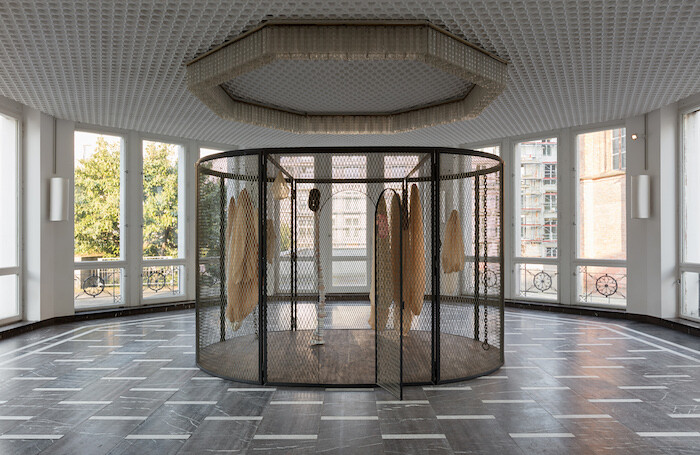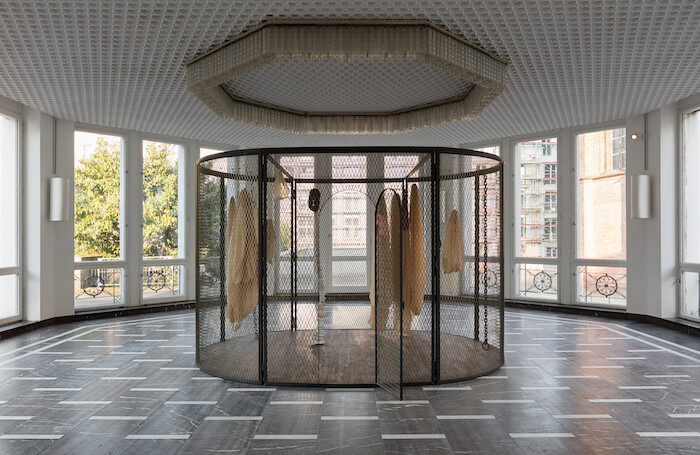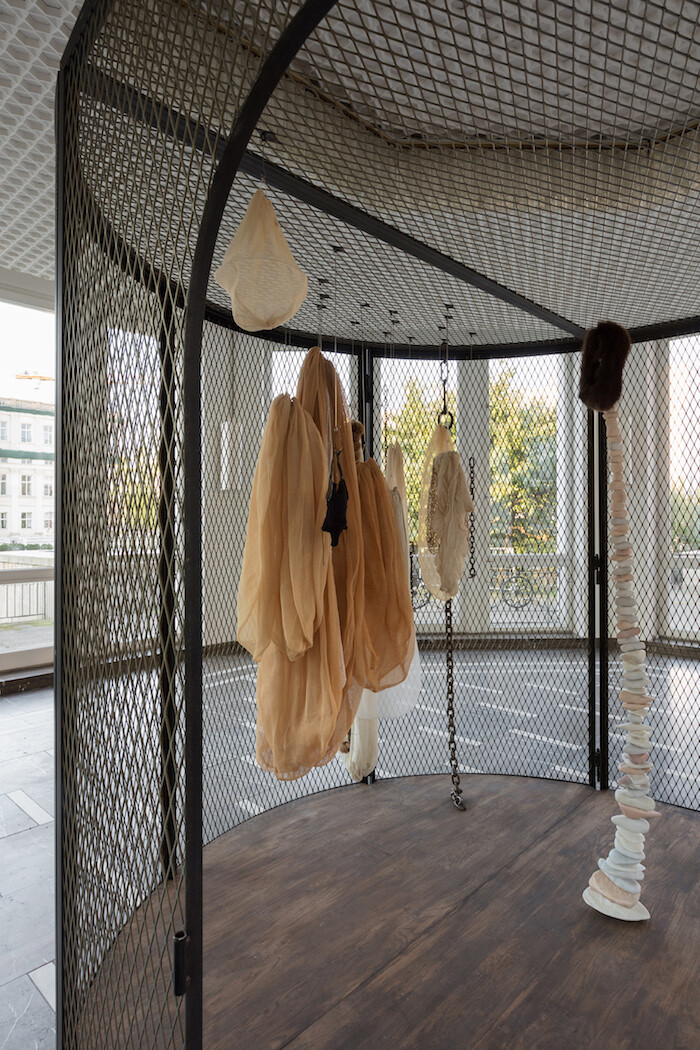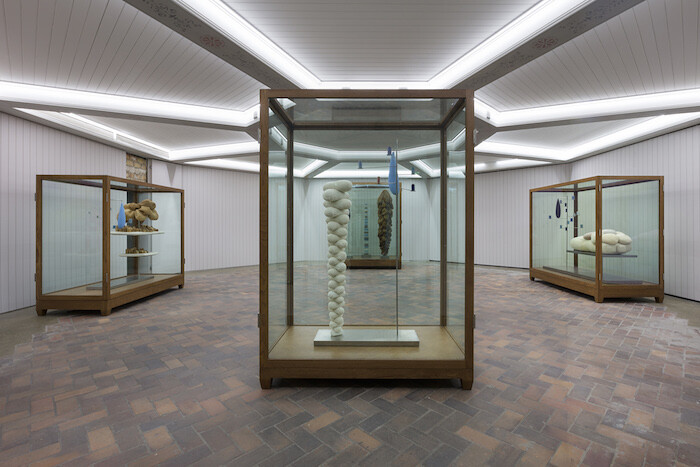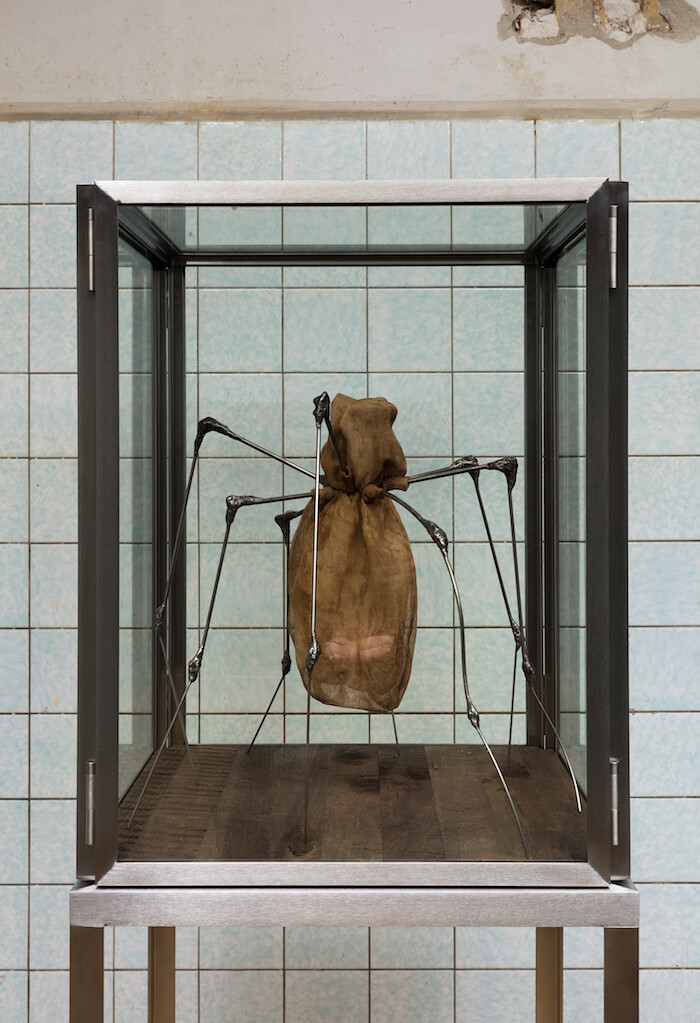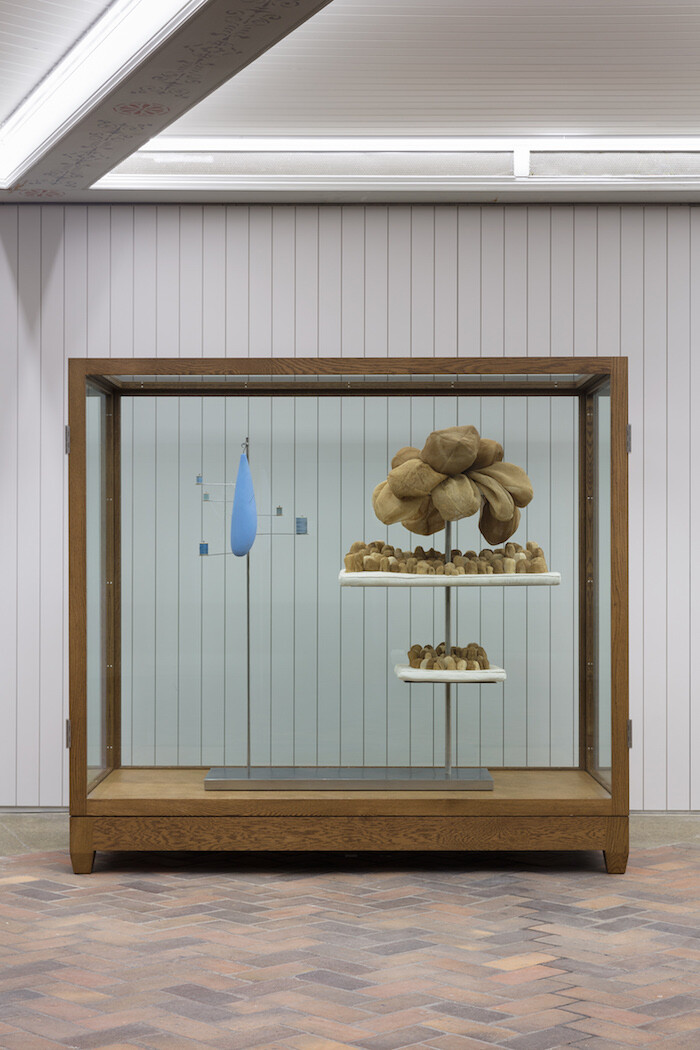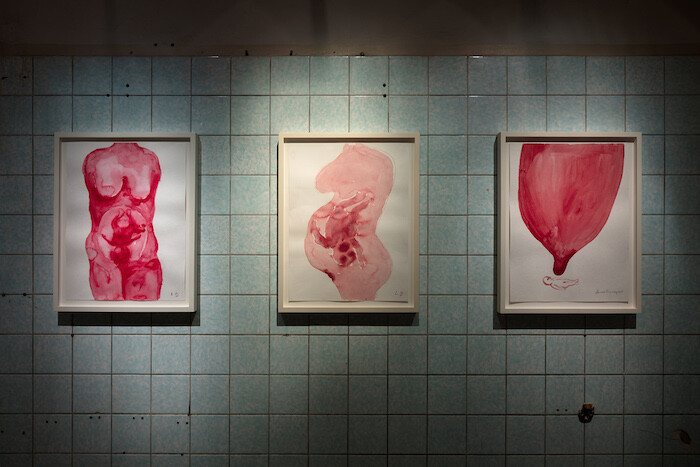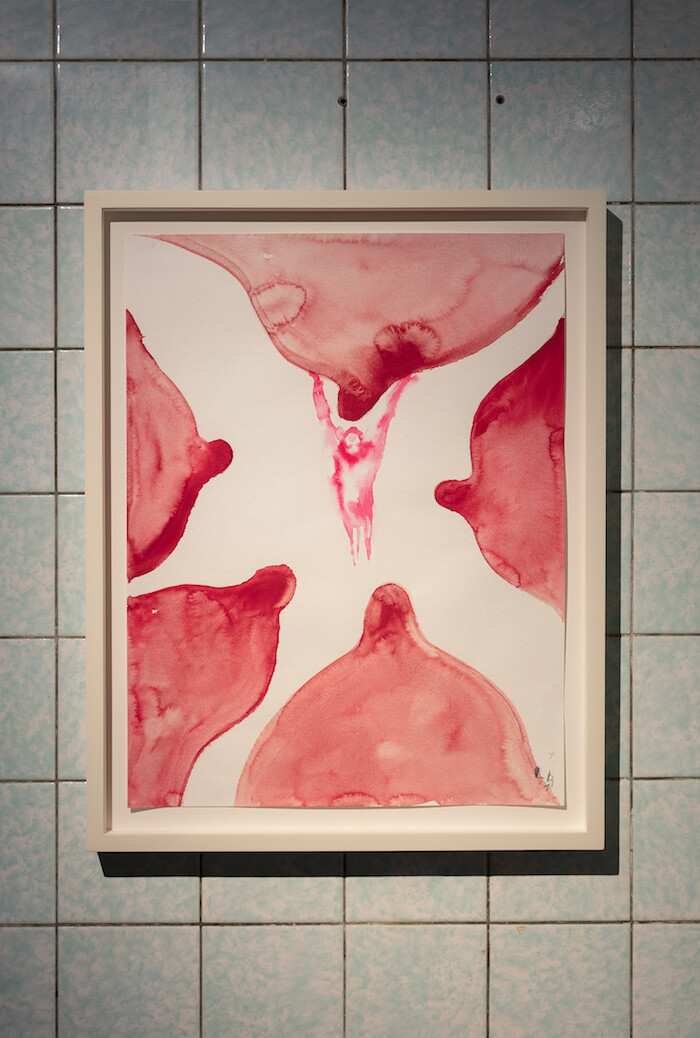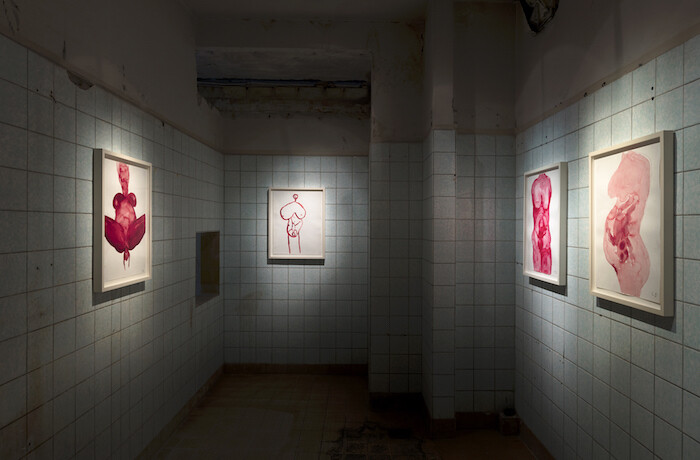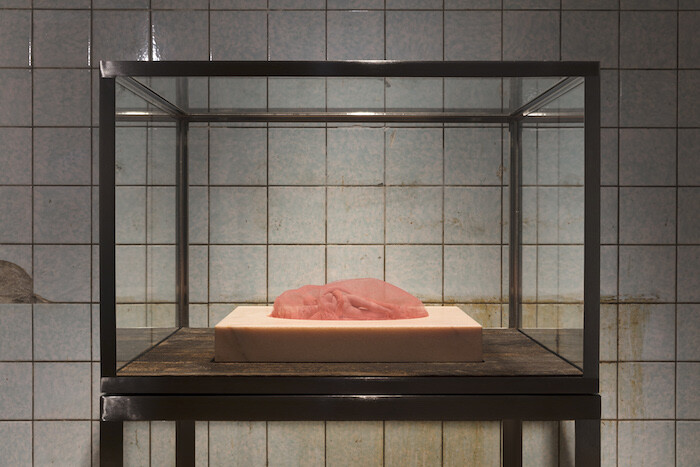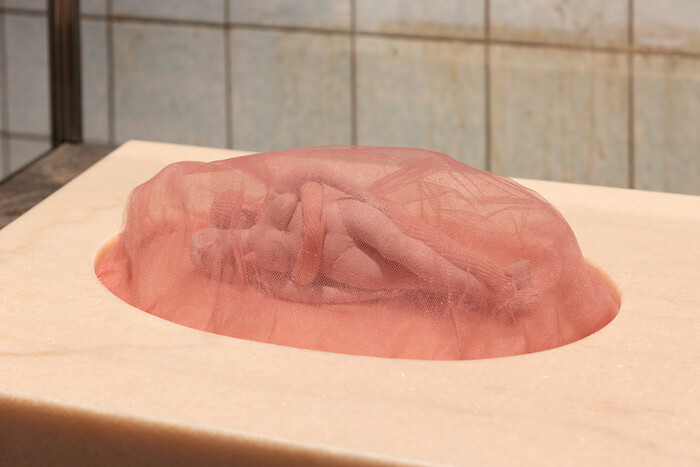It’s intimidating to review the work of an artist the stature of Louise Bourgeois, about whom so much has been written, to whom so much has been ascribed. Bourgeois’s life spanned nearly the entire twentieth century and helped redefine what a (feminist) artistic practice can be, how art can intertwine with life. Her legacy is outsized, but Berlin’s Schinkel Pavillon—a nonprofit art space in a GDR-era structure, run since 2007 by artist Nina Pohl—has put together a portrait of Bourgeois’s late work that is accessible and intimate.
The pavilion’s main space, an octagonal room with floor-to-ceiling windows, hosts a single work: one of the “cells” that Bourgeois began making in the early 1990s. Peaux de Lapins, Chiffons Ferrailles a Vendre [Rabbit skins, Scrap Rags for Sale] (2006) is an oval metal cage in the room’s center containing other sculptures: two humanoid figures, hand-sewn in dark fabric, hang upside-down like voodoo dolls from an apparatus attached to the cell’s ceiling. Also suspended are textile sacks, mostly in shades of beige and cream (one is hot pink), arranged in flock-like groups. A thin stack of white marble stones ascends from the cell’s wood floor—atop this elegantly curved “spine” hangs an old-fashioned fur headband. Two thick metal chains connect the vertical space top to nearly bottom.
The cell is seductive but unsettling. I visited the show twice: oddly, the cell’s door was once closed, once ajar; in images of the show, however, the door is wide open. Bourgeois’s cells have been described as “structures of existence” that protect or enclose the artist’s psychological space, but the metal cage also seems meant to protect viewers from direct contact with her unfiltered emotional microcosms. (In her later life, Bourgeois revealed that her father had had a long-term affair with her beloved English nanny when she was a child: an early, traumatic betrayal that became a genesis myth of her oeuvre.) The hanging sacks also evoke decay, disuse, or simply age—in gauze, netting, and what appears to be nylon, the forms read as deflated female body parts: sagging breasts, collapsed wombs, or the empty living spaces that artist often referred to in her writings. In a text quoted in the exhibition pamphlet, Bourgeois writes: “The woman and the sack/the sack becomes a tube/it’s a river/it’s a sack, it’s a pocket, it’s a house/the sack is precious, safe, beautiful.” She also refers, in a diary entry dated November 1991, to the sack as an “empty house”—“the deprived woman = the empty house”—which lends this exhibition its title.1
In the pavilion’s lower level, a windowless room features four large works, vitrines encasing discrete objects in glass and wood frames, like windows peering into Bourgeois’s interior rather than the cell’s cage-like enclosures, made in her last three years and never before shown together.2 Conscious and Unconscious (2008) repeats the spinal motif with a vertical stack of stone-like knit pillows in white. Beside this, perched on a metal rod, is a teardrop-shaped textile sculpture pricked with needles whose threads lead to spools on metal “branches.” Variations on this tree-like arrangement appear in each vitrine paired with other objects, such as a tower of squared textile cushions; many more sacks arranged into sculptural landscapes or a pillar; and a limbless pillow-torso whose chest is covered with multiple breasts sewn from the felted wool berets Bourgeois wore. Late in her career, the artist often created works from her old clothes, like foundation garments and wool hats.
In a small side room lined in blue tile, a series of gouaches from the 2000s depict pregnancy, birth, and motherhood in watery layers of red. Shown together in this tight space, they’re incredibly powerful: I had a visceral flashback to my own pregnancy. In a second side room, small vitrines display works like Umbilical Cord (2003), a hand-sewn, armless, pregnant fabric figure in a transparent chiffon belly containing a tiny fetus doll. The huge mother spider is Bourgeois’s signature motif, but this show’s Spider (2003) is small enough to rest on a plinth, with spindly legs in knotty metal and a beige sack, filled with an unidentifiable meal, as head and body. This spider is less like a mother than a spinster, watching and waiting.
No matter how much has been said or written about Bourgeois’s preoccupation with the body and the spaces around it, her material experiments, her psychoanalytical approaches, her depictions of sexuality—and no matter how many giant spiders draw crowds to the world’s museums—her work’s unapologetic intimacy is its strongest pull. The Schinkel Pavillon’s cool architectural rigidity provides the perfect contrasting frame. “The Empty House” could be seen as an elegant mini-retrospective of the artist’s last years, as well as a meditation on the sack form that she so often repeated in this period. More importantly, it is also a haunting reflection on the emptiness, and fullness, that is a woman’s life.
Louise Bourgeois quoted in the Schinkel Pavillon exhibition guide, 2018.
All works were culled from private collections and Tate’s collections; the process took two years and funding from multiple sources. Bourgeois’s former assistant Jerry Gorovoy worked in close collaboration with Nina Pohl.
